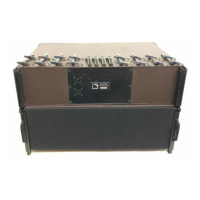dV-DOSC dV-SUB Manual V3.0 June 2005 91
3.5 SUBWOOFER ARRAYING TECHNIQUES
3.5.1 LEFT/RIGHT CONFIGURATIONS
Any L/R subwoofer configuration will have problems with the so-called “power alley” effect, i.e., a
build up of low frequency energy in the centre accompanied by uneven low frequency response and
impact off-axis in the horizontal plane. This is easy to understand using Fresnel analysis, i.e., in the
centre, the distance to L/R arrays is identical so that signals arrive in phase and sum while destructive
or constructive interference will occur off-axis, depending on listener position and the frequency of
interest. For example, if on-axis to the L array and a series of Fresnel rings is drawn, the R array could
fall in a destructive ring and cause cancellation. In general, L/R subwoofer arrays are only desirable for
long, narrow audiences where the centre build up effect is less of a problem (since the venue is
narrow and we don’t mind focusing energy up the middle).
Past attempts at reducing the power alley effect for L/R arrays have included complementary comb
filtering applied to the left and right signal feeds for the subwoofer arrays (see: “Use of Stereo
Synthesis to Reduce Subjective/Objective Interference Effects: The Perception of Comb Filtering”,
Augspurger et. al. AES preprint 2862, New York 1989). The main limitations of this approach are
reported to be changes in timbre and a potential loss of overall energy. The preferred option is either
an LCR configuration or electronic delay processed systems (see Sections 3.5.2 and 3.5.3).
Despite the fundamental limitations of L/R subwoofer arrays, some recommendations and basic
guidelines are made in the following. Figures 70 (a), (b), (c) and (d) show techniques for optimizing low
frequency tonal balance over the audience while 70 (e) shows a non-recommended configuration.
In Figure 70a, ground stacked L/R subwoofers are arranged in a block with minimum frontal surface
area and are physically separate from the flown dV-DOSC/dV-SUB arrays. When subwoofers are
configured in the manner (i.e., with minimum front surface area or in a vertical column as in Fig 70b
there is reduced center build up and fewer horizontal lobing problems compared with the results
obtained using two L/R horizontal subwoofer line arrays as shown in Fig. 70e (not recommended).
Basically, interference effects between two omnidirectional sources (Figs. 70 a,b) are less dramatic
than between two directive sources (Fig 70e). For the vertical column configuration (Fig 70b) there is
the added advantage of effectively extending the length of the dV-SUB array at low frequencies for
improved low frequency pattern control and throw in outdoor open air applications (X preset
recommended).
In Figure 70(c), the L/R subwoofer arrays are configured in an L-wrap around the stage corner in an
attempt to direct low frequency energy offstage and reduce centre build up. Physically curved L/R
subwoofer arrays as shown in Fig. 70(d) are a variation on this configuration.
Figure 70(e) shows a non-recommended configuration since two L/R horizontal subwoofer line arrays
emphasize the center build up problem. In this case, the individual L/R arrays are more directive in the
horizontal plane than the configurations of Figs 70(a,b) so that center build up is greater and there are
more pronounced horizontal lobing effects. However, this configuration can be used if electronic delay
processing is applied to the individual columns of the L/R arrays in order to obtain the equivalent
performance of Fig 70(d).
Figure 69 shows a variation for the flown coplanar dV-SUB configurations pictured in Figs 70(a,c,d)
that is suitable for arena sound reinforcement. In this case, both dV-SUB arrays are flown offstage to
the main FOH L/R dV-DOSC arrays and the arrays furthest offstage are angled 45 degrees. Arraying
dV-SUB in this manner (80 Hz preset, less than 2.1 metre separation between columns
recommended) allows coupling between the dV-SUB arrays while helping to provide low end impact
for both main FOH L/R and offstage LL/RR dV-DOSC arrays (plus for nostalgics, there is the added
benefit that it resembles a conventional PA system!).
Note: The rigging plot should be adjusted to provide 6-7 metre spacing between L/R and LL/RR arrays (see
also Section 3.3 Multiple Arrays)

